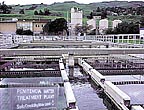Bioterrorism is the buzzword of the moment. The news media have been throwing around the term like it's going out of style, but for good reason, as we know all too well. Anthrax is being mailed to unsuspecting individuals, and recipients of those letters and postal workers alike sadly are dying. We are all wondering, what will be besieged next?
A recent poll by Newsweek shows that the majority of people feel that our water could be in jeopardy. The magazine found that 61 percent of those polled said i t was at least somewhat likely that a water supply would be the next target for a terrorist attack.
Those of us who deal with ground water have certainly entertained this scary notion already. But questions linger about the likelihood or feasibility of such an attack. How easy would it be to poison a water system? Which systems are in the most danger?

The Current Scenario
According to the report "Threat of Water Supply Bioterrorism: Who Will It Impact?" the events of Sept. 11 have prompted an unmatched domestic security response by the United States. However, the analysis, which was drafted by the market consulting firm Fr ost & Sullivan, says that despite the recent security fortification and a nationwide commitment to make water treatment systems more secure in the future, these measures will do little to stop a determined terrorist.The report goes on to explain, tho ugh, that even though most large water systems in the country were built more than 50 years ago and were therefore not designed to combat bioterrorism, they still have a inherent and formidable defense: their size. The large systems are so big that it wou ld most likely take an amazingly large amount of a contaminant to effectively harm the drinking water supply. As an example, the report states that to cause death or debilitation to someone drinking one glass of water, terrorists would need over 400,000 m etric tons of hydrogen cyanide to poison the Crystal Springs Reservoir, which supplies San Francisco with part of its drinking water supply. Of course, the analysis reminds, reservoir sizes and contaminant concentrations may vary, but it would nevertheles s be extremely difficult to contaminate an entire reservoir or aqueduct.
Small systems, though, are not so lucky. The report says that it is conceivable for terrorists to obtain enough toxins to poison the small systems or smaller parts of larger syst ems. Also, security measures at small systems may be feeble or absent, making these facilities easier targets. Because of their greater vulnerability to bioterrorism, the report concludes by suggesting that the federal government provide more funding to t hese smaller - perhaps non-community - systems rather than spending lots of money on ex-cessive security measures like aerial patrols at larger facilities.
The report also touches on the possibility of contaminating treatment plants, saying that alth ough residual chlorine is the most significant defense against many contaminants, some such as anthrax are resilient to chlorine. Also, if a terrorist could deactivate the chlorination system, much damage could be done.
Pipes downstream from these facilities also could be in danger, the bioterrorism analysis says. While the high pressure contained in the pipes makes it difficult to inject a contaminant, the report recognizes that the lack of security could make pipes an easier target than a water tank.
Government Assessment
We've heard what the independent analysis of the situation, but what does the government think of the threat of water supply contamination? During a recent visit to the Washington Suburban Sanitary Commission Consolidated Laboratory in Silver Spring, Md., Environmental Protection Agency Administrator Christie Whitman sought to allay fears for the security of the nation's water systems. Whitman said, "People are worried that a small amount of some chemical or biological agent - a few drops, for instance - could result in significant threats to the health of large numbers of people. I want to assure people - that scenario just can't happen."She went on reiterate the point that large water systems would be difficult to contaminate. "It would take large amounts of contaminants to threaten the safety of a city water system," she said. "Because of increased security at water reservoirs and other facilities around the country - and because people are being extra vigilant as well - we believe it would be very difficult for anyone to introduce the quantities needed to contaminate an entire system."
While Whitman did not specifically address the threats to smaller systems, treatment plants or downstream pipes, she did admit that despite small probabilities and stepped-up prevention, there are no "iron-clad guarantees." She explained, however, that systems already in place for treating drinking water before it comes out of the tap will, in many cases, remove the immediate threat to public health.
Report Abusive Comment